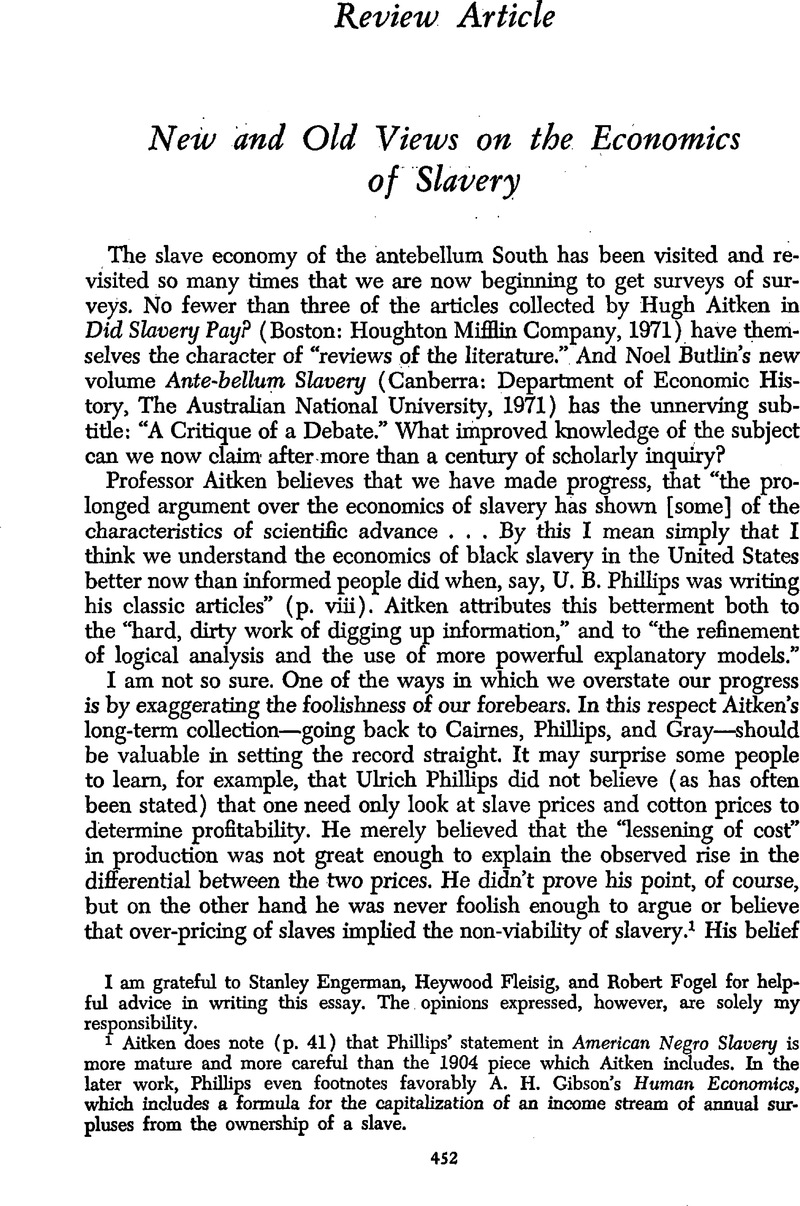Published online by Cambridge University Press: 11 May 2010

I am grateful to Stanley Engerman, Heywood Fleisig, and Robert Fogel for helpful advice in writing this essay. The opinions expressed, however, are solely my responsibility.
1 Aitken does note (p. 41) that Phillips’ statement in American Negro Slavery is more mature and more careful than the 1904 piece which Aitken includes. In the later work, Phillips even footnotes favorably A. H. Gibson's Human Economics, which includes a formula for the capitalization of an income stream of annual surpluses from the ownership of a slave.
2 Phillips,, Ulrich B.American Negro Slavery (New York: D. Appleton and Co., 1918), p. 375.Google Scholar
3 Cairnes,, J. E.The Slave Power (Torchbook Edition, New York: Harper and Row, 1969Google Scholar; originally published 1862), Appendix I.
4 There appear to be numerous computational or typographical errors in this chapter. The most serious of these occurs on p. 74, the general case of rent calculation, in which the cost terms on the right do not sum to $2280, as indicated.
5 Phillips’ strongest statement came early in his career. In 1904, he wrote: “If the abolition agitation had never arisen in its violent form to blind the Southerners to their own best interests, it is fairly probable that within the nineteenth century slavery would have been disestablished in some peaceable way in response to the demand of public opinion in the South” (South Atlantic Quarterly, III, January 1904).Google Scholar As guarded and qualified as the statement is, I doubt that Phillips would have repeated it in later years. In any case, his mechanism is “public opinion,” not economics (at least directly), and he never associated this opinion with his views on profitability. Ramsdell was far more emphatic on the future of slavery, but he too invoked in the end a political mechanism for slavery's demise (“The Natural Limits of Slavery Expansion,” Mississippi Valley Historical Review, XVI, September 1929, p. 170)Google Scholar, albeit a political mechanism stimulated by declining economic fortunes. Hence Ramsdell is not quite fully refuted by Yasuba's argument that capitalized rents were very high in the late antebellum period.
6 See Becker,, Gary“Irrational Behavior and Economic Theory,” Journal of Political Economy LXX (February 1962).Google Scholar
7 Fogel, Robert and Engerman, Stanley (eds.), The Reinterpretation of American Economic History (New York: Harper and Row, 1971), Chapter 24, pp. 331–333.Google Scholar
8 Genovese,, Eugene D.The Political Economy of Slavery (New York: Pantheon Books, 1965), p. 281.Google Scholar
9 Ibid., p. 284.
10 Hammond,, M. B.The Cotton Industry (New York: published for the American Economic Association by The MacMillan Company, 1897), p. 255.Google Scholar
11 The headiness of southern thinking on cotton prices is well illustrated by an editorial in The New. Orleans Bee (March 5, 1860): “Cotton, too, continues to command handsome remunerative prices, because, immense as is the crop, it does not exceed the demand.” The only effect of indefinite expansion, wrote The Bee, “will be to stimulate manufactures without lowering the price of the article.” See Dumond, D. L. (ed.), Southern Editorials on Secession (Gloucester, Mass.: Peter Smith, 1964; originally published 1931), pp. 48–50.Google Scholar
12 Rainwater,, Percy“Economic Benefits or Secession,” Journal of Southern History, I (November 1935), p. 474.Google Scholar
13 Ibid., pp. 464–465.
14 Moore,, John H.Agriculture in Ante-Bellum Mississippi (New York: Bookman Associates, 1958), p. 207.Google Scholar
15 The Daily True Delta, December 9, 1860. Reprinted in D. L Dumond, Southern Editorials …, pp. 312–315.
16 Wright, Gavin and Passell,, Peter“The Effects of Territorial Expansion on the Price of Slaves,” Journal of Political Economy, LXXX (November/December 1972).Google Scholar
17 See Wolff,, Gerald“The Slavocracy and the Homestead Problem of 1854,” Agricultural History, XL (April 1966)Google Scholar; Yarwood,, Dean“Legislative Persistence: A Comparison of the United States Senate in 1850 and 1860,” Midwest Journal of Political Science, XI (May 1967).Google Scholar
18 Phillips,, Ulrich B.The Course of the South to Secession (New York: Hill and Wang, 1964; originally published 1939), p. 145.Google Scholar I should note that Phillips had argued earlier that the closing of opportunities for westward migration would lead to a “relaxation of the restraints of slavery.” See “Plantations with Slave Labor and Free,” American Historical Review, XXX (July 1925).Google Scholar This was a markedly weaker position than this view of 1904.